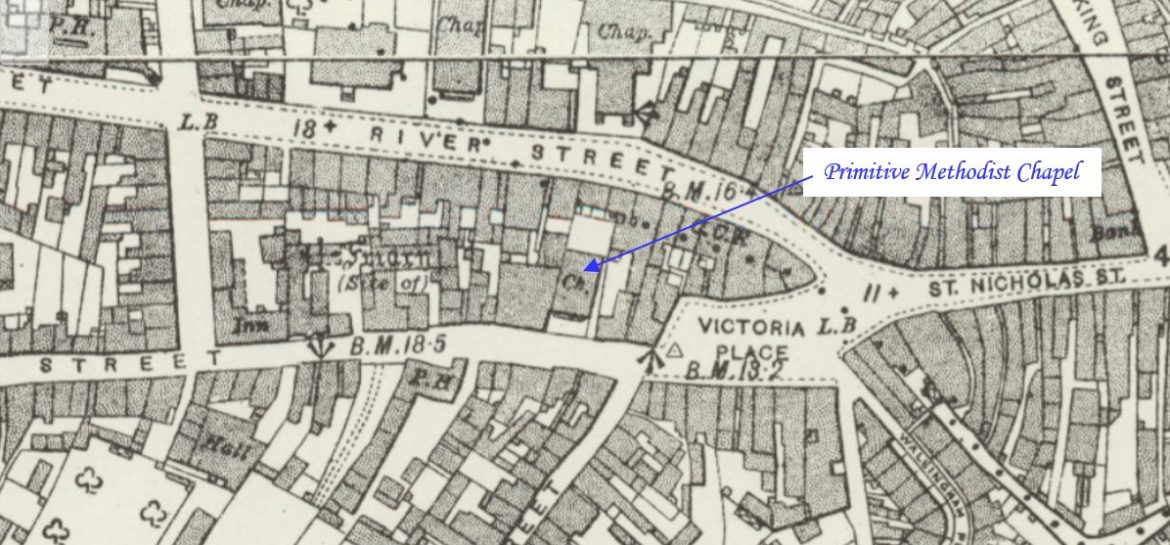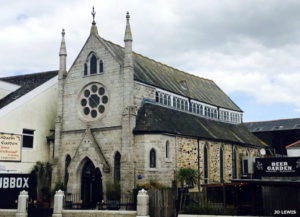
This profile of Truro Primitive Methodist Chapel has been compiled by Tony Mansell.
Primitive Methodist was always weak in Truro, establishing a presence only on the fourth attempt, in 1862 – from a remnant of a Mormon group occupying a room in Mill Place. Its circuit – often conjoined with Falmouth circuit – was in the PM Missions District, rather than the Bristol District to which the other Cornish circuits belonged. After periods in a warehouse at the back of East Bridge Street, the Public Rooms in Quay Street and the Walsingham Place mission hall vacated by the WM, the society built a chapel in Kenwyn Street. After years of struggle, it closed in 1941 and the building was taken over by the (formerly WM) City Mission society. (A Dictionary of Methodism)
Primitive Methodist chapel is now used as commercial premises. Dressed granite with show front. Interesting Gothic style example with pinnacled buttresses, rose window and clerestory over aisles. (Cornwall Heritage Gateway)
1827: “The Primitive Methodists are now holding camp-meeting in various parts of this county. On Sunday last, several thousand persons assembled of these occasions, on a common within three miles of Truro, on the Redruth Road, when discourses were delivered different preachers.” (North Devon Journal – Friday 14 September 1827)
The Primitive Methodist movement was always weak in Truro, establishing a presence only on the fourth attempt, in 1862 – from a remnant of a Mormon group occupying a room in Mill Place. Its circuit – often conjoined with Falmouth circuit – was in the PM Missions District, rather than the Bristol District to which the other Cornish circuits belonged. After periods in a warehouse at the back of East Bridge Street, the Public Rooms in Quay Street and the Walsingham Place mission hall vacated by the WM, the society built a chapel in Kenwyn Street. After years of struggle, it closed in 1941 and the building was taken over by the (formerly WM) City Mission society.
Worshipping in a warehouse in East Bridge Street.
Worshipping in the Public Rooms in Quay Street.
Worshipping in the Walsingham Place Mission Hall, possibly a wooden building.
1870s Chapel
1875: Site acquired in Kenwyn Street for new chapel.
1878: “The Connexion has for long time past been worshipping in the Public Rooms [Quay Street]; but great inconvenience has been experienced in carrying the services.” (Western Morning News – Tuesday 16 July 1878)
1878: Build date. (SWChurches)
1878: Chapel opening. (The Cornish Telegraph – Tuesday 17 December 1878)
1878: “New Primitive Methodism at Truro. Yesterday the memorial stones of a new Wesleyan Methodist chapel at Truro were laid in the presence of a large concourse of spectators… The building, which will be in the early English style, will be 50 feet 3 inches long and 30 feet wide on the interior, and will accommodate 326 adults, 230 on the ground floor and 90 in an end gallery. The front will be constructed of granite, and above the entrance door will be a large rose window. The staircases will be built on the outside of the body the building, and furnished with hipped roofs, ornamented at the eaves. The seats will be constructed with solid ends and reclining backs, and in place of a pulpit there will be a rostrum. The front of the building will be fenced with granite pillars with moulded caps, and ornamental gates and railings of cast iron. The architect is Mr. J. Wills, from Kingsbridge and Victoria Chambers, Derby; and the builders Messrs. Julian and Son. Truro. It is estimated that the building will cost £948, exclusive of proposed schoolroom, etc., which are not included the present contract…” (Western Morning News – Tuesday 16 July 1878)
1896: There seems to have been a move to sell the chapel to the City Mission but it did not happen.
1905: Truro Primitive Methodist Chapel was closed for necessary alterations. Incandescent light was installed and the pulpit had been re-positioned. Efforts were being made to build a schoolroom. (Royal Cornwall Gazette – Thursday 30 March 1905)
1906: Plan, new schoolroom, Primitive Methodist Chapel, Kenwyn Street, Truro. (Kresen Kernow DCCRK/888/305)
1906: “Truro Primitive Methodist Church. Tenders are invited for the erection of Schoolroom adjoining the above Church. Specifications and plans and other information may be seen at the office of Mr. J. Phillips, 32, Ferris Town, Truro, to whom tenders must be sent before Saturday, Sept. 29th.” (Royal Cornwall Gazette – Thursday 20 September 1906)
1906: “Truro Primitive Methodists having for many years conducted their Sunday school classes in the church, have now launched out on a scheme to build a school adjoining the church at a cost of £200. Messrs. Harris and Son are the builders, and on Friday afternoon the foundation-stones were laid in the presence of several people, although rain descended in torrents…The Sunday school there had been without proper accommodation for 26 years but was now to looked after. The building would be 30ft. by 20ft., and they would also add a vestry. The cost would be about £200, towards which they had received £50…” (Royal Cornwall Gazette – Thursday 25 October 1906)
1907: Opening of new Sunday School. (West Briton and Cornwall Advertiser – Monday 13 May 1907)
1907: Falmouth and Truro Primitive Methodist circuit held their centenary camp meeting at Penryn. (Royal Cornwall Gazette – Thursday 15 August 1907)
1913: Whether due to dwindling funds or to finance a new project, Truro Primitive Methodist Chapel received a grant from the Connexion.
1926: Certificate of registration, Kenwyn Street Primitive Methodist Chapel, Truro. Certificate of registration for religious worship. (Kresen Kernow MRT/768)
1926: Certificate of registration, marriages, Kenwyn Street Primitive Methodist Chapel, Truro. (Kresen Kernow MRT/769)
1932: The Wesleyan, Primitive Methodist and the United Methodist Church amalgamated to become the Methodist Church of Great Britain.
1932: Became Kenwyn Street Methodist Church. (SWChurches)
1939: The chapel and society closed.
1942: The premises were taken over by the Methodist City Mission. (SWChurches)
1976: Premises closed and sold. (SWChurches)
Became Dowty’s Furniture Store and then a restaurant.
 The building in use as a restaurant (Photo: Jo Lewis)
The building in use as a restaurant (Photo: Jo Lewis)
